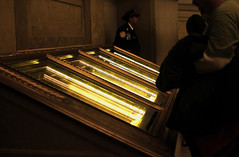
‘National Archives Document Lighting’
courtesy of ‘Mr. T in DC’
This came to us as a special contribution of one of our photographers, Erin McCann
Via the Post comes word today that the National Archives has decided to ban photography. That means that after next month, unless you are a professional photographer, you’ll be forbidden from using a camera inside the building whose No. 1 purpose is to display the documents of freedom on which our country was founded.
Archives officials opened the issue for public comment last summer with an announcement in the Federal Register. (What? You don’t scour the register?) After two months, they had only three comments, all of which were against a change in policy. Despite this, David S. Ferriero, the chief archivist for the United States, wrote that the agency “does not believe that this rule will create problems for tourists. The agency believes this rule creates a better visitor experience.”
With all due respect to Mr. Ferriero, it’s troubling that such a fundamental alteration of the visitor experience was made without considering the millions of people for whom a camera is an important part of the visitor experience. The First Amendment guarantees our right to create images, to capture life, to tell stories. That he would deny us that right in the very building housing the Bill of Rights is outrageous.
There are two points the Archives is citing to justify the ban: The first is that flash photography damages the precious documents; the second is that photographers ruin the experience for everyone else. Both blame photographers for the failure of Archives employees to adequately control their crowds. We’re being punished because some tourist from South Dakota doesn’t understand how to work his camera. The logic is maddening, and it dismisses the importance of documentary photography. You know all those old pictures the museums around town—Archives included—have displayed on their walls? They weren’t created by fairies, Mr. Ferriero
The announcement includes the helpful reminder that “for those visitors who wish to take home an image of the documents, the National Archives Shop has facsimiles of various sizes and price ranges available for purchase.” It’s not just about the documents, though: photographers document the experience of the archives. It’s through the work of amateur photographers and tourists that we can document the mood of this living, breathing DC monument.
The agency has branded itself with an invitation to the National Archives Experience. Apparently, there’s only one way to experience the National Archives, and those us who see life through a lens are not welcome to participate.
At this point, the policy change seems inevitable. Over at DC Photo Rights we’re mourning the policy change, and there’s talk of a photo walk being planned on Feb. 20.



This is complete and total bullshit.
As a photographer I share the dislike of this new policy. However I think this one glib bit undermines your point: “We’re being punished because some tourist from South Dakota doesn’t understand how to work his camera.”
I’ve shot weddings and portraits, used equipment ranging from 35mm to 6×4.5 medium format, natural light, 3-strobe studio setups and probably more stuff I’ve forgotten.
And about four years ago, after being reminded not to use my flash and assuring the person taking me on a one-one-one tour through NASA’s VAB – the vertical assembly building where final prep is done on the space shuttle – I handed my pocket camera to someone to take a picture and left the flash enabled.
People, no matter how experienced, screw up. I’m not sure that a complete ban is the way to go and I wonder whether there’s not some superior way to cope with the occasional screw-up. But you could just as easily flip your statement over and ask “why are future generations having their opportunity to see this document put at risk just so some people can continue to take their own version of pictures of something that’s been photographed a million times?”
I am obviously a believer in the value of experiencing something through photography, but let’s not be glib.
I see the contradiction between not being able to take photos of the documents that guarantee your right to take photos, but agree that we shouldn’t jeopardize the longevity of these documents by exposing them to flash photography.
I do not agree with the second statement that photography ruins it for everyone else – I’m not sure I understand their point on that one.
If it were possible to only allow cameras in that didn’t have a flash, that would be ideal, but that policy is too difficult to enforce. Also, most tourists are bound to have point and shoot cameras which all have a built-in flash, and many of them take pictures using the flash, even if they’re taking a picture of the Washington Monument on a sunny day.
Lastly, don’t hate on South Dakota. :)
Pingback: uberVU - social comments
No argument, if flash is damaging the documents that takes priority, but slipping this in the Federal Register? Claiming this will be a “better visitor experience”?
If you only get three comments, that’s because your outreach is bad, not that no one cares about the topic. Heck, this blog post already has four comments. The Archives is doing this poorly.
Having recently been to the Archives, taking several photographs including the one above (no flash of course!), I totally agree with Erin here. Not happy with this policy change. :(
Pingback: Tweets that mention National Archives to Ban Photography » We Love DC -- Topsy.com